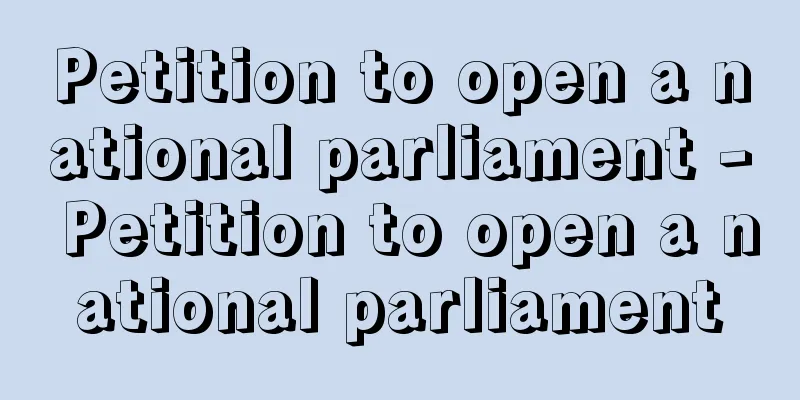Petition to open a national parliament - Petition to open a national parliament

|
A national movement that demanded the establishment of a national parliament through petitions and other means to the Meiji government. On January 17, 1874 (Meiji 7), eight people, including Itagaki Taisuke, Soejima Taneomi, Goto Shojiro, Eto Shinpei, and Furusawa Shigeru, submitted a petition for the establishment of a popularly elected parliament to the Left House as a resolution of the Aikoku Koto. The Aikoku Koto was Japan's first political party, formed mainly by councilors who had resigned from office, and the petition was one of the triggers of the movement, but its argument was that political participation was limited to the samurai class and wealthy farmers and merchants. On June 9, 1877, the Risshisha Petition, which listed eight points of government mismanagement, was submitted to the Anzaisho in Kyoto, and for the first time included basic national demands for the civil rights movement, such as the establishment of a national parliament, the reduction of land taxes, and treaty revision. The Aikokusha, which was formed in 1875 by bringing together local freedom and civil rights associations, gradually dissipated, but was revived in 1878. At its third convention the following year, political associations from around the country, mainly consisting of wealthy farmers, also participated, and a resolution was passed to submit a petition for the establishment of a national parliament. At the fourth convention in 1880, 114 representatives from two prefectures and 22 prefectures, who had received petitions from more than 100,000 people, gathered and were newly established as the National Diet Promotion Alliance, and Kataoka Kenkichi, Kono Hironaka, and others submitted a petition for the establishment of a national parliament to the Dajokan. Apart from this "tide of Aikokusha-affiliated political organizations," another driving force behind this movement was the "tide of local civil rights associations" (also called the "village-based trend," the "non-Aikokusha line," or the "prefectural assembly member-led line"), which was mainly comprised of wealthy local farmers who had achieved political growth through the anti-land tax reform movement and activities in the People's Assembly and Prefectural Assembly. In particular, the "Draft to Request the Opening of a National Diet," in which Sakurai Shizuka, a village assembly member in Chiba Prefecture, called on prefectural assembly members from all over the country to hold a Tokyo meeting to discuss how to open a national diet, greatly inspired activists in various regions. Iwate, Niigata, Nagano, Ibaraki, Yamanashi, Okayama, Hiroshima, Fukuoka, and other prefectures quickly responded, and began signature-gathering campaigns and the formation of political organizations. Their method was to use influential village figures such as county clerks, prefectural assembly members, and household heads to take the lead and use their credibility to thoroughly persuade people. In some places, like Okayama, they collected over 25,000 signatures within a few months, published a manifesto called "A Message to Our Fellow Compatriots and Brothers" pleading for the establishment of a national parliament, and traveled to Tokyo. This manifesto encouraged many young people, and was even recited by heart. The movement to petition for the establishment of a national Diet gained momentum as these two currents, the "patriotic" and "non-patriotic," merged and spread throughout the country. In the eight years from 1874 to 1881, 90 memorials and 40 petitions were drafted and submitted, with the peak coming in 1880 when the National Diet Promotion Alliance was formed. More than 319,000 people signed these petitions from every prefecture except Okinawa and Miyazaki, with particularly high numbers in Kochi, Chiba, Hiroshima, Okayama, Kanagawa, and Nagano. This wave of petitions was a major force in drawing up the imperial edict promising the establishment of a national Diet ten years later. Furthermore, on November 7, 1884 (Meiji 17), as the date for opening the National Diet as promised by the government drew near, a "Petition to Shorten the Deadline for Opening the National Diet," which had been resolved at the Liberal Party's dissolution convention, was submitted to the Senate, and through the following year, 1885, movements to submit similar petitions were seen all over the country. [Katsuhiro Arai] "Study of the Freedom and People's Rights Movement" by Naito Masanaka (1964, Aoki Shoten)" ▽ "Freedom and People's Rights" by Goto Yasushi (Chuko Shinsho)" ▽ "Japanese History 25: Freedom and People's Rights" by Nagai Hideo (1976, Shogakukan)" ▽ "Freedom and People's Rights" by Irokawa Daikichi (Iwanami Shinsho)" ▽ "Study of the Freedom and People's Rights Revolution" by Eiichi Emura (1984, Hosei University Press) [References] | | | |Source: Shogakukan Encyclopedia Nipponica About Encyclopedia Nipponica Information | Legend |
|
明治政府に対して、国会の開設を建白書や請願書などによって要求した国民的な運動。1874年(明治7)1月17日、板垣退助(たいすけ)、副島種臣(そえじまたねおみ)、後藤象二郎(しょうじろう)、江藤新平(しんぺい)、古沢滋(ふるさわしげる)ら8名は、愛国公党の決議として民撰(みんせん)議院設立建白書を左院に提出した。愛国公党は下野した参議を中心に結成された日本における最初の政党で、建白書はこの運動の一つの引き金となったが、その主張は士族と豪農商層に限っての政治参加を求めたものであった。77年6月9日には、8項目にわたって政府の失政をあげた立志社建白が、京都の行在所(あんざいしょ)に提出され、民権運動の基本的要求である国会開設・地租軽減・条約改正などの国民的課題が初めて掲げられた。75年に各地方の自由民権結社を結集して結成された愛国社は、その後自然消滅していったが、78年に再興され、翌年の第3回大会では、豪農層を中心とする各地の政社も参加し、国会開設願望書の提出が決議された。80年の第4回大会には、2府22県、約10万人余の請願委託を受けた114人の総代が集まり、国会期成同盟として新発足し、片岡健吉、河野広中(こうのひろなか)らによって国会開設願望書が太政官(だじょうかん)に提出された。 一方、こうした「愛国社系政社の潮流」とは別に、この運動のもう一つの原動力となったのは、地租改正反対運動や民会・府県会活動を通して政治的成長を遂げた地方の豪農層主体の「在地民権結社の潮流」(「在村的潮流」とか「非愛国社路線」「県議主導路線」などともいわれる)である。とくに千葉県の一村議桜井静(しずか)が、79年7月に、全国の府県会議員に、国会開設の方法を協議する東京集会を開くことを呼びかけた「国会開設懇請議案」は、各地の活動家に大きな刺激を与えた。岩手、新潟、長野、茨城、山梨、岡山、広島、福岡などが、いち早く呼応し、署名獲得運動や政社の結成に向かった。その方法は、郡書記、県議、戸長などの村の有力者が先頭にたって、その信望を利用しながら、徹底した説得方式をとるものであった。岡山のように、数か月のうちに2万5000余人の署名を集め、国会開設を懇請する檄文(げきぶん)「同胞兄弟に告ぐ」を発表し、上京してきたところもある。この檄文は多くの青年たちを励まし、暗唱もされたという。 国会開設請願運動は、これら「愛国社系」と「非愛国社系」の二つの潮流が合流して一気に盛り上がり、全国へと広がっていった。1874年から81年の8年間に起草・提出された建白書は90件、請願書は40件で、国会期成同盟が結成された80年がピークとなっている。これらに署名参加した者は、沖縄と宮崎を除く全府県から31万9000人以上を数え、とくに高知、千葉、広島、岡山、神奈川、長野などが目だって多い。この請願の波が、10年後の国会開設を約束した詔勅を引き出す大きな力となった。 なお、政府の公約した国会開設の時期が近づいた1884年(明治17)11月7日、自由党解党大会で決議された「国会開設期限短縮建白書」が元老院に提出され、翌85年にかけて、同様の建白書提出の動きが各地でみられた。 [新井勝紘] 『内藤正中著『自由民権運動の研究』(1964・青木書店)』▽『後藤靖著『自由民権』(中公新書)』▽『永井秀夫著『日本の歴史25 自由民権』(1976・小学館)』▽『色川大吉著『自由民権』(岩波新書)』▽『江村栄一著『自由民権革命の研究』(1984・法政大学出版局)』 [参照項目] | | | |出典 小学館 日本大百科全書(ニッポニカ)日本大百科全書(ニッポニカ)について 情報 | 凡例 |
<<: Member of the Diet - KOKKAIGIIN
>>: Black Sea (English spelling) Чёрное Море/Chyornoe More Russian
Recommend
Sanbongi [town] - Sanbongi
A former town in Shida County, central Miyagi Pref...
Chrezvychainaya komissiya po bor'be s kontrrevolyutsiei i sabotazhem
The All-Russian Extraordinary Committee for Comba...
prevailing visibility
…If the weather conditions at an airport fall bel...
Political Economy Club
…He retired from the front line of the business w...
Foreign Exchange Law - Gaitameho
This law is intended to manage and regulate foreig...
Turbidimeter - turbidimeter
A device that measures the degree of cloudiness of...
Bandits - Bazoku
An armed group of horsemen that existed in northe...
Stone slab
〘Noun〙 (also "sekihan") A printing metho...
Kalámai (English spelling)
…A port city in the southern part of the Peloponn...
Fridtjof Nansen
Norwegian Arctic explorer, naturalist, and politi...
Garrison duty order - eijukinmurei
…A garrison was a military unit of the former Jap...
Childerich III
?‐754 The last Frankish king of the Merovingian dy...
Euglena (green worm) - Euglena
Euglena is a green, single-celled algae that grows...
Work Accident - Work Accident
Accidents such as injury, illness, and death that ...
Larval reproduction - larval reproduction
This is a form of parthenogenesis, in which repro...







![Arsaces [I] - Arsaces](/upload/images/67cf4581b80ce.webp)

